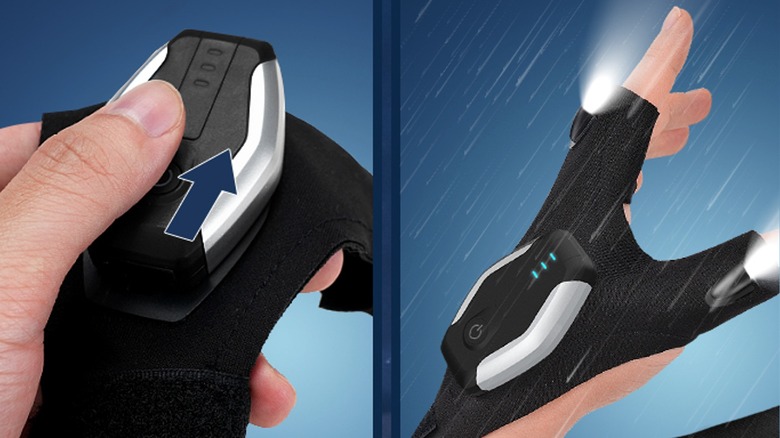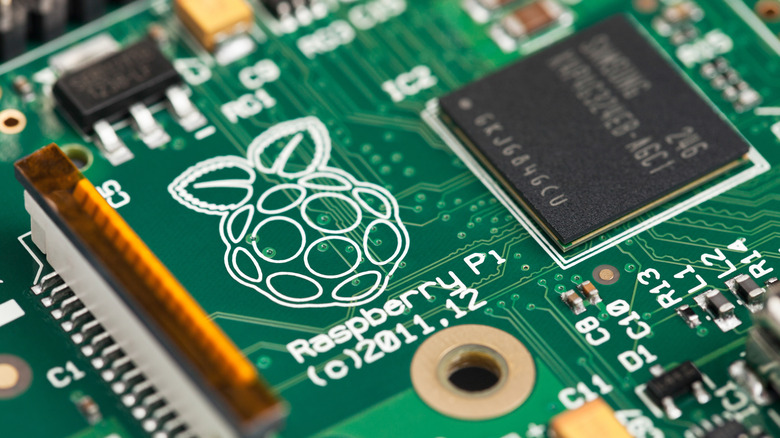10 Stocking Stuffer Ideas Every Nerdy Adult Will Geek Out Over
We may receive a commission on purchases made from links.
With the holiday season already here, we all need a few ideas for gifts and stocking stuffers. If you've got a nerdy adult in your life or a fan of science fiction and science fact who is leaving you wondering about what to get them, these stocking stuffer suggestions will help point you in the right direction.
The kids of yesteryear who grew up playing Dungeons & Dragons, building elaborate K'Nex sets, and camping out for the "Star Wars" prequels are now grown up. Of course, they still love pop culture, science fiction and fantasy, and playing with fun little gadgets. The ideal nerdy stocking is filled to overflowing with all manner of tools, toys, and technological trinkets.
We've got suggestions for grown up geeks of all flavors, dipping into nostalgia, DIY, amateur science, and more. These stocking stuffers celebrate the kid inside all of us by leaning into childlike wonder with a grown up twist.
Universal socket wrench
Anyone who spends time doing at-home renovations or DIY projects knows that losing a socket wrench is as common as it is cliche. They're small and even the most fastidious DIYer can lose them over time. If that sounds like someone in your life, a universal socket wrench might be the perfect stocking stuffer.
Instead of being manufactured to a precise shape, a universal socket wrench uses an array of small metal cylinders to grab onto hardware of various shapes and sizes. Our review of the Gator Grip universal socket wrench found it to be useful at grabbing oddly shaped hardware like hooks and moderately good at general use.
This universal socket wrench from HANPURE is compatible with hardware between ¼ inch and ¾ inch or 7mm and 19mm. It can be tough to get into tight spaces, which does limit its use, and you'll get better mileage using a purpose-made socket wrench of the correct size, but it works well enough if you're missing a socket or dealing with an oddly shaped piece of hardware. You probably shouldn't toss out your socket set just yet, but a universal socket wrench can be a good supplement to your existing tool bag. Just don't lose this one too!
TinyTV 2
The TinyTV 2 from TinyCircuits is perfect for the fan of retro technology. It's a bite-sized recreation of an old boxy CRT TV set. When we say tiny, we mean tiny, as it sports a screen that's just 1.14 inches — but don't let its diminutive stature fool you. The TinyTV 2 works much like the classic TVs from years past.
Importantly, while the TinyTV 2 looks like your old CRT, it's actually a tiny LED display. It comes in either a classic brown or transparent shell with a small speaker mounted in the front. Each set comes preloaded with stock videos and you can load your own content by converting any MP4 file using the free TinyTV Converter tool and a USB-C cable connected to a PC. You can also stream content directly to the TinyTV 2 when connected to a computer. Charging takes place via the same USB-C and a full charge gives you about two hours of watch time.
For a tactile bit of nostalgia, the TinyTV 2 features two rotary knobs to change the channel or adjust the volume. It also comes with a tiny remote control. 8GB of built-in storage holds up to 10 hours of video and you can set individual files to specific channels and flip through them by turning the channel knob. If you're looking to fill out your tiny tech collection, TinyCircuits also offers a tiny arcade, a tiny handheld gaming console, and more.
Eilik, the robotic desktop friend
The adult geeks of today grew up on promises of a future filled with robotic roommates, friends, and assistants. In one version of that potential future, advanced machines like the T-1000 or HAL 9000 subjugate humanity with their mechanical might. In another version of the future, robots like Marvin the Paranoid Android, the Iron Giant, R2-D2, and Optimus Prime are our friends and companions.
While advanced robots with military applications – and absolutely zero personality besides — have made headlines in recent years, Eilik and other desktop robots like it are an attempt to bring the friendlier form of robotic interaction into our daily lives.
Eilik is a virtual pet that is a natural evolution of the Tamagotchis of our youth and highly interactive. It won't fold your laundry for you or help you fight a galactic empire, but it just might be the artificial buddy your loved one has been looking for. Eilik's face features a digital display capable of illustrating a number of emotions and reactions. Sensors on its body elicit different responses and the robot's personality changes over time, influenced by how you interact with it. In addition to keeping you company, Eilik can play games and has other useful functions, like setting alarms for you. Additionally, if you get more than one then they'll even interact and play together.
Transforming flash drive
For the grown up geek, you can never have too many flash drives. Commonly called thumb drives or thumb sticks, flash drives take their name from the flash memory they utilize. They typically work like a tiny dedicated hard drive for you to store files or transfer them between machines. Data is stored electronically in a solid state drive where it can be recovered, meaning that flash drives contain no moving parts. At least, they usually don't.
This flash drive from Sea Tech holds 64GB of your loved one's favorite files, but that's not what makes it special. The drive is branded with the Transformers logo and it unfolds to become a roaring robotic cat. This transforming flash drive is more than meets the eye!
Sure, you can get a beefier flash drive with more storage and faster writing speed for around the same price point, but it won't be as fun to use or as cool to pull out of your pocket. After all, when it comes to simple everyday objects like flash drives, sometimes it's what's on the outside that counts.
Flashlight gloves
Never hold a flashlight in your teeth again! Whether you work on cars, identify plants, animals, and rocks on night hikes, or paint tabletop game miniatures, you've probably found yourself wishing for an extra hand when working in the dark and holding a flashlight. Headlamps are a common hands free solution, but these flashlight gloves take things to the next level.
They're typically marketed toward mechanics and they certainly work for that. If you've got a gearhead in your life, consider your job done, as these gloves will simplify working in poorly lit and hard to reach spaces. Of course, they'll work just as well for sorting through comic books in the wee morning hours as they do for baiting your hook on an early morning fishing trip.
These fingertip flashlight gloves from BIIB slip over your thumb and forefinger before strapping around your wrist, leaving the rest of your palm and fingers unrestrained. The fabric is a breathable polyester, and the open design provides plenty of airflow for long work sessions. Compact LED flashlights are mounted at the first knuckle of the thumb and forefinger, separated by a rechargeable battery block and power button. These gloves with built-in fingertip lights will keep your loved one's hands free and their work in the spotlight.
Raspberry Pi
Raspberry Pi was created with the mission of making computers and programming more accessible to kids, but they can be just as fun and educational for adults. If you've got a loved one who's always wanted to experiment with building a computer, coding their own games, or anything in between, a new Raspberry Pi kit will give them everything they need to get started.
This all-inclusive Raspberry Pie set comes from CanaKit, which is an authorized Raspberry Pi reseller. It includes a 4GB Raspberry Pi 4, a 32GB Micro SD card for storage, a shell with a built-in fan mount and system fan, a USB-C power supply, heat sinks, HDMI cable, and a CanaKit power switch. Building your first computer can be overwhelming and intimidating, but a Raspberry Pi kit offers a low-cost, low-risk way to dip your toes in the technological waters.
If you're looking for something a little different than the CanaKit set, Raspberry Pi offers several different models, each with their own benefits and limitations. Depending on the intended use, you can find models for as little as $10 and many models can be upgraded with peripheral attachments. Once you've chosen your Raspberry Pi, you can build your own self-contained computer, Wi-Fi extender, a retro gaming arcade machine, and more. Check out these suggestions for even more Raspberry Pi project ideas!
Ultrasonic levitator kit
This ultrasonic stocking stuffer is two gifts in one. First, your loved one will get the joy of building their new gadget and then they'll get the fun of playing with it. Most of the difficult assembly has been done for you, but the DIY ultrasonic levitator from VIGURTIME requires some minimal soldering to make it ready for show time.
The kit comes with instructions, bagged components, and some small foam spheres for you to levitate. It stands about three inches tall when assembled. The device itself is relatively simple, using interacting soundwaves to create stable areas where small objects can float that relies on a process known as acoustic levitation.
So how does it work? You probably know there is no sound in a vacuum — in space, no one can hear you scream — because there aren't any molecules for the sound waves to interact with. On earth, we have molecules aplenty and acoustic levitators use that to their advantage. As a sound wave travels, it pushes the molecules it's traveling through, according to its wavelength. Levitators use specific sound waves interfering with one another to create a standing wave with nodes of minimum pressure.
Here on Earth, the points just below the nodes have an upward pressure equal to the downward pressure of gravity. Stick a small object in that spot and it'll stay there as long as those two forces remain balanced. It's some very cool science in the palm of your hand.
Tiny Stirling engine
Shopping for a steampunk aficionado, history buff, or a fan of neat gadgets? This miniature Stirling engine uses hot air to move a piston, generate electricity, and power a small LED light. It's not exactly useful, but it is a cool demonstration of historical tech.
Unlike internal combustion engines, the working fluid of a Stirling engine remains forever contained inside the engine itself. Also known as hot air engines, these were invented by Robert Stirling in 1816 as a hopeful competitor to the then-fledgling steam engine. They work by applying an external heat source to an air tight chamber filled with gas. As the gas warms, it expands and moves a piston. Then it cools and returns as part of the Stirling cycle. Since there aren't any exhaust gasses, Stirling engines have the potential to be totally green, if heated by solar or other renewable sources.
Despite the simplicity of the engine, early designs had relatively low working pressure and subsequently low power output. Later improvements made Stirling engines more efficient and more powerful but they never successfully supplanted steam. Hot air engines are sometimes used in submarines because they are especially quiet and they briefly powered the Dundee iron foundry in the mid-nineteenth century, but that was about the peak of their industrial might. What once was considered a potential heavy hitter of the industrial revolution can now enjoy its retirement on your loved one's desk.
Pocket microscope
If you've ever been intimidated by a laboratory microscope, this is your chance to take a look at the hidden microscopic world all around you. The EasyMicro pocket microscope features very few moving parts and is basically point and look. There's a built-in LED light near the lens to provide illumination in low light, but you might not need it when observing lichens, bugs, and other tiny things outside during the day. Two knobs allow you to pull focus and zoom up to 120X magnification, powerful enough to see some bacteria and other microbes.
No one really knows who made the first microscope, but they gained prominence in the 17th century as lens crafting techniques improved. The instrument was instrumental in the development of the field of microbiology and the emergence of modern medicine.
While it's not quite as powerful as the ones used by scientists, this microscope is small enough to fit in a pocket or travel bag, ready to be unleashed at a moment's notice. It comes with eight prepared sample slides and two blank slides for collecting your own samples. It even includes an adapter to attach the microscope to your smartphone camera for snapping pics or recording microscopic video.
Periodic table with real elements
About 14 billion years ago — give or take a few hundred million years — the universe was an unimaginably hot and dense singularity, then spacetime began. Soon, cosmically speaking, the first particles emerged and then the first atoms. In the beginning it was all hydrogen and helium, the heavier elements would have to wait to be forged in the hearts of stars and the violent explosions of supernovae.
Today, the universe has cooked up quite a few new chemical ingredients – 118 that we know of – from the carbon that comprises our bodies to the plutonium that powers our spaceships, and all things in between. The periodic table is a way of organizing the building blocks of reality and of understanding their characteristics. It even allows scientists to predict, discover, and synthesize previously unknown forms of matter.
This cool periodic table represents everything that is, as far as we know. More than just an image, this table includes samples of most of the elements preserved inside. Some are intentionally missing, though, either because they are rare, difficult to synthesize, short-lived, or radioactive. It does have carbon however, meaning this is one of the few times you can give someone coal for Christmas and they'll thank you for it.










